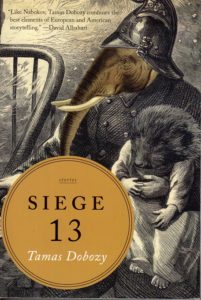Book Review: Siege 13 by Tamas Dobozy
During World War Two, Hungary was one of the Axis powers, with its own fascists led by the Arrow Cross Party. At first this seemed like a good idea, as Hungary gained back territories it had lost after the breakup of the Austro-Hungarian Empire. But late in the war, it became obvious that they were on the losing side. The Hungarian government tried to broker a separate armistice with the Soviet Union, only to have their country occupied by the Germans. As a result, they were forced to fight to the bitter end.
In late December of 1944 through February of 1945, the Soviet Army encircled the city of Budapest and besieged the troops and civilians within. It is that siege that gives us the title of this book, which contains thirteen short stories all of which tie into that event in some way, even if the characters are living in the Hungarian diaspora community in Toronto.
“The Atlas of B. Görbe” is about a struggling writer in New York City who turns to an older author of children’s books for assistance in finding his way.
“The Animals of the Budapest Zoo, 1944-1945” is set within the siege itself as the zookeepers come to realize they might not be able to keep themselves alive, let alone their charges, and the extreme steps one of the keepers takes.
“Sailor’s Mouth” takes place in Romania, where a man has come to adopt a child of Hungarian heritage. He may have become misled by his carnal urges. One of the themes in this story is “The Museum of Failed Escapes” that Judit, the woman the man is seeing, tells him about.
“The Restoration of the Villa Where Tíbor Kálmán Once Lived” concerns a deserter who joins the Communist occupation after the war. He takes over the home of a man who used to provide people with false papers to escape the Axis, and betrays their names to the Soviets one by one. But he gets the distinct feeling the villa is rejecting him…this one won an O. Henry award.
“The Beautician” is about a college student preparing his thesis paper. He finds a possible topic in the dark past of the manager of the club for Hungarian exiles in Toronto. But is that something he really wants to make known?
“Days of Orphans and Strangers” follows up on the Kálmán family mentioned in “Restoration.” One of them has been talking in his sleep, but not in the language you’d expect.
“Rosewood Queens” concerns the narrator’s relationship with her father’s lover, a collector of chess pieces (but never full sets.)
“The Encirclement” is about a lecturer on the topic of the Budapest siege, who finds himself with a persistent blind heckler who presents a different version of events. The details are too close to be fake, but that’s not the way the lecturer remembers it. I thought this story was the best in the book.
“The Society of Friends” features a long-standing love triangle among three Hungarian emigres. It reminded me a bit of the movie Grumpy Old Men. It shares a character with “Beautician.”
“The Miracles of Saint Marx” concerns a secret police officer’s search for a dissident who spreads tales of miraculous events. It becomes personal when one of those stories is about her. Also very good.
“The Selected Mug Shots of Famous Hungarian Assassins” is about a boy who handcrafts trading cards featuring what he says are Hungarian assassins. It seems to be all his imagination, until the narrator finds a book on the same topic years later… This story includes slurs against people with mental disabilities as a plot point, getting the boys in deep trouble.
“The Ghosts of Budapest and Toronto” is another tale of the Kálmán family. Ghosts are seen in two cities as separated members of the family miss each other.
“The Homemade Doomsday Machine” finishes the volume with a genius child who seeks the destruction of society and the Nazi atomic scientist who shares that interest. Has perhaps the happiest ending in the book. Has a character that seems too eager to diagnose the child as autistic, especially as she has no psychological or medical training.
Most of the stories are bittersweet, with a few downer endings. I found the writing competent but not compelling on average.
There are frequent mentions of rape, and suicide comes up a time or two. While the travails of the Jewish and Romani people in Hungary are mentioned, the emphasis is on ethnic Hungarians. There’s some period sexism and a number of the female characters express dislike of the patriarchal Hungarian family culture. Due to the heavy themes, I’d recommend this for college age and up.
Overall, I am glad I got the chance to read this. Books on the Hungarian experience are uncommon, and I discovered much I did not know. Recommended for other people wanting to broaden their experience.

